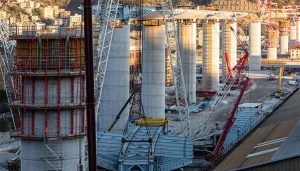 The last concrete giant is finished. Everything is ready to wrap up work on Pylon 12 for the new Genoa bridge, one of the 18 pillars that will support a span of over 1,000 metres (3,280 feet) to replace the Morandi Bridge that collapsed in August 2018.
The last concrete giant is finished. Everything is ready to wrap up work on Pylon 12 for the new Genoa bridge, one of the 18 pillars that will support a span of over 1,000 metres (3,280 feet) to replace the Morandi Bridge that collapsed in August 2018.
Construction on Pylon 12 is an important milestone in the race to bring the city back to normal.
The 18 pillars supporting the bridge are concrete skyscrapers 90 metres high (295 feet), 50 meters of which is below ground. They were built in record time.
The construction companies (Salini Impregilo and Fincantieri Infrastructure) only gained access to the west side of the worksite on April 15 2019, and initially could only work in limited areas because the remnants of the old bridge were still being removed. Access to the east side was only permitted in August 2019.
This means that in just four and a half months the foundations, pillar bases and pillars themselves were built in the east side, at a rate of two pillars per month. This speed is the result of teamwork, both in terms of management and of manpower. Hundreds of people have worked on the site since the beginning, with daily peaks of 600 people. If we consider the satellite industries, that number rises to 1,000.
Concrete skyscrapers
The size of the concrete pillars reveals a lot about the magnitude and stability of the new bridge.
The pillars are concrete skyscrapers anchored to the ground through about 250 poles driven into the earth. The external above-ground part is 40 metres (131 feet) high. Stacked one on top of another, they would reach a height of 1,450 meters (4,757 feet), twice the size of Dubai’s Burj Khalifa, the world’s tallest skyscraper. Their shape has been designed with the closest attention to the smallest detail. Each pillar’s cross-section has an elliptical shape, allowing the light to glide better on the surface of these giants and to lessen the visual impact on the urban landscape around them.
Raising each pillar is a complex process, managed by a team of skilled workers.
«Each of these people made a valuable contribution, working day and night, over three 8-hour shifts, from 6 in the morning to 2:00 PM; from 2:00 PM to 10:00 PM and from 10:00 PM to 6:00 AM», said Ercole Biella, the pouring manager of Cossi Costruzioni (a struggling company recently acquired by Salini Impregilo and now working to rebuild the bridge).
Biella checks how the work on the last of the pylons is proceeding and admits: «I feel like smiling, because of all the hard work and sleepless nights spent to reach this goal. When I look at these pylons, I can’t help but feel happy about the teamwork we achieved».
A work unlike any other
The completion of the last pillar is another step towards a common goal: to complete the construction of the bridge in the shortest possible time. Reaching this goal calls for everyone to work together, and also to reach production and organizational excellence on the worksite.
«What we have done in recent months is a source of pride for all of us», said Pietro Salini, CEO of Salini Impregilo in an interview on the worksite. «Over 600 people working together towards one goal. From the bridge’s design to the way we have organized the construction site, from the logistics of supplying the materials to their installation, each step of this work is the result of shared effort and a meticulous organization derived from our experience gained in the largest construction sites around the world».
The giant pillars rising up from the ground and the bridge they will support are different from other infrastructure projects.
«This new bridge is a unique project from many points of view», said Salini. «It’s different in terms of construction schedule, pressure, and the attention of public opinion, the quality and safety of the workmanship. And of course, the reason why it is being built. We knew from the beginning that building a new bridge over the rubble of the Morandi would not be a routine job. We accepted this commitment with a spirit of service to our country and to the inhabitants of Genoa».

